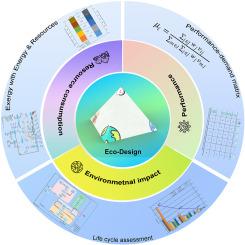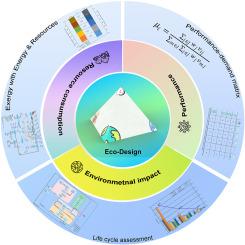Integrating sustainability into material design and selection through eco-design: A case study on aluminum alloy plates
IF 10
1区 环境科学与生态学
Q1 ENGINEERING, ENVIRONMENTAL
引用次数: 0
Abstract
Traditional material design focuses primarily on performance, properties, structure, and synthesis. Growing environmental awareness necessitates the integration of sustainability considerations into material design and selection. This paper introduced an approach that embeds the eco-design method within material comparison to balance performance requirements and environmental sustainability. Five types of aluminum alloys were examined to demonstrate and validate the proposed method. The alloys are commonly used in shipbuilding and have varying contents of the rare earth element Erbium. The alloys were assessed through a performance-requirement matrix, life cycle assessment, and exergy calculation to evaluate their performance, environmental impact, and resource consumption. A binary integrated decision model was created to compare the five alloys based on either their performance and environmental impact or their performance and resource consumption. Additionally, ternary integrated decision models were formulated to yield a comprehensive analysis of the five alloys, considering all three aforementioned factors. A matrix model was established to allow for comparative assessment no matter how many indicators are involved. Furthermore, a model based on the enumeration method was presented to mitigate the bias introduced by weighting factors. This methodological approach aids in selecting the most suitable alloys for diverse scenarios, thereby enhancing the sustainability of material design.


通过生态设计将可持续性融入材料设计和选择:铝合金板案例研究
传统的材料设计主要侧重于性能、特性、结构和合成。随着环保意识的不断增强,有必要将可持续发展因素纳入材料设计和选择。本文介绍了一种在材料比较中嵌入生态设计方法的方法,以平衡性能要求和环境可持续性。本文研究了五种铝合金,以展示和验证所提出的方法。这些合金通常用于造船,稀土元素铒的含量各不相同。通过性能要求矩阵、生命周期评估和放能计算,对合金的性能、环境影响和资源消耗进行了评估。创建了一个二元综合决策模型,根据性能和环境影响或性能和资源消耗对五种合金进行比较。此外,还制定了三元综合决策模型,以对五种合金进行综合分析,同时考虑上述所有三个因素。建立了一个矩阵模型,无论涉及多少指标,都可以进行比较评估。此外,还提出了一个基于枚举法的模型,以减少加权因素带来的偏差。这种方法有助于针对不同情况选择最合适的合金,从而提高材料设计的可持续性。
本文章由计算机程序翻译,如有差异,请以英文原文为准。
求助全文
约1分钟内获得全文
求助全文
来源期刊

Journal of Cleaner Production
环境科学-工程:环境
CiteScore
20.40
自引率
9.00%
发文量
4720
审稿时长
111 days
期刊介绍:
The Journal of Cleaner Production is an international, transdisciplinary journal that addresses and discusses theoretical and practical Cleaner Production, Environmental, and Sustainability issues. It aims to help societies become more sustainable by focusing on the concept of 'Cleaner Production', which aims at preventing waste production and increasing efficiencies in energy, water, resources, and human capital use. The journal serves as a platform for corporations, governments, education institutions, regions, and societies to engage in discussions and research related to Cleaner Production, environmental, and sustainability practices.
 求助内容:
求助内容: 应助结果提醒方式:
应助结果提醒方式:


